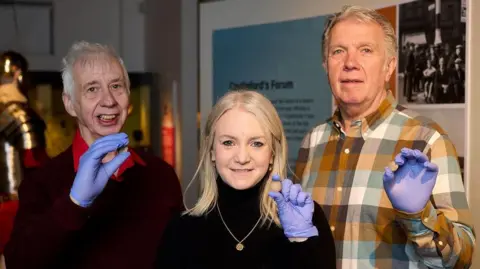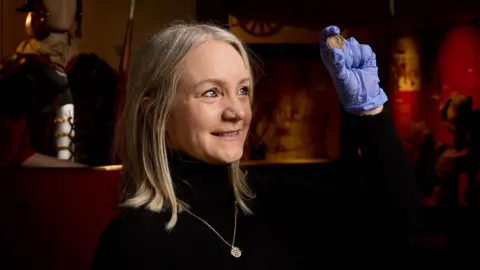Roman coin moulds used for forgeries go on display
 Wakefield Council
Wakefield CouncilCoin moulds which were used for counterfeiting money during Roman times are to go on display in a West Yorkshire museum.
The moulds were discovered at Ackton Meadows in Castleford and are thought to date to about AD260 when the Roman world was undergoing a period of political instability and coins were in short supply.
Hannah Appleyard, Wakefield Council's cabinet member for culture, leisure and sport, said the moulds would add to the wealth of Roman history on show at Castleford Museum.
"This latest find paints a fascinating story of life in our district almost 2,000 years ago. They'll have pride of place alongside the other Roman artefacts in Castleford so people can find out more," she said.
"It's very important to preserve our archaeological heritage for future generations to enjoy.
"So, we'll be working with the West Yorkshire Archive Service to protect and categorise these new discoveries."
 Wakefield Council
Wakefield CouncilThe find was uncovered during an excavation by West Yorkshire Archaeological Services ahead of the construction of a new housing development.
Speaking on BBC Two's Digging for Britain, excavation manager Dave Williams said the site probably formed part of a settlement on the outskirts of Roman Castleford.
He said: "We knew very little about the site before we started. We put some trenches in and that started turning up archaeological features with Roman pottery in them."
In the first century AD, the Roman army set up camp on the River Aire and built a fort called Lagentium, on which modern-day Castleford is built.
'Fakes and copies'
Roman coin moulds have been found in the area before, according to Wakefield Council.
More than 300 moulds, dated to around AD238, were found at Lingwell near Wakefield between 1695 and 1830.
Many of these are featured in the Castleford Museum collection, which also includes Roman coins found in Castleford during excavations in the 1980s.
Some of the earliest coins were made of bronze and then coated in silver to make them look like solid silver.
Coin expert Murray Andrews told Digging for Britain that the method found on site was a standard way of making counterfeit coins.
He said: "It's often a way of making more valuable coins out of less valuable materials. Counterfeiting was a crime in the Roman empire and punishable by crucifixion.
"It's a time in which there's hyperinflation and prices are rising so people use fakes and copies instead."
Many other examples of Roman coin moulds have been found in neighbouring South Yorkshire, suggesting there was a regional black market industry, according to Wakefield Council.
Listen to highlights from West Yorkshire on BBC Sounds, catch up with the latest episode of Look North or tell us a story you think we should be covering here.
